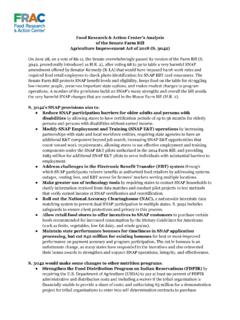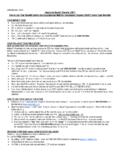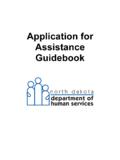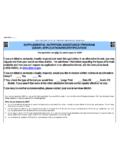Transcription of ResearchWIRE - frac.org
1 ResearchWIRE . Welcome to the Food Research & Action Center's spring issue of ResearchWIRE . This quarterly periodical e-newsletter focuses on the latest research, reports, and resources from government agencies, academic researchers, think tanks, and elsewhere at the intersection of food insecurity, poverty, the federal nutrition programs , and health. SNAP Benefits Need To Be Made Adequate, Not Cut or Restricted The supplemental nutrition assistance Program (SNAP) is one of the crown jewels of public policy. More than 40 million children, parents working at low wages, seniors, people with disabilities, veterans, members of the active duty military, unemployed working-age adults, and others receive SNAP in an average month. FRAC's new brief, SNAP Benefits Need To Be Made Adequate, Not Cut or Restricted, outlines the numerous values of this federal program, how attacks APRIL 2018 on the program misunderstand the breadth of the program, why the proposals IN THIS ISSUE to restrict SNAP foods are misplaced, and policy solutions that exist to improve n In Focus: SNAP Benefits SNAP beneficiaries' health.
2 Highlights from, and a link to, the document are Need To Be Made provided below. Adequate, Not Cut or Restricted Effectiveness and The Faces of SNAP. n Research Highlights: Value of SNAP Each month in recent years, about supplemental nutrition A surge of recent research has shown 1 in 8 Americans participated in assistance Program how vital SNAP is to a wide variety of SNAP. Over longer periods of time (SNAP). the nation's most important health, the program reaches an even larger Child nutrition employment, education, and other share of the population. An estimated programs In addition to the program's one-half of all children will receive Physical and Mental effectiveness, SNAP is efficient SNAP benefits at some point during Health because it provides access to normal childhood; and half of all adults will use Race and Nativity streams of food commerce and also SNAP at some point by age 65. Food Insecurity preserves the dignity of beneficiaries Attacks on SNAP and its Research by making the food-purchase smooth beneficiaries often are based on and akin to all other commercial food stereotypes that do not acknowledge n From Children's HealthWatch: purchases through the use of an these demographics that the face of Food Insecurity: electronic benefits card at all types of SNAP is the face of much of America.
3 An Avoidable Cost food outlets. And proposals to reshape the FRAC ResearchWIRE n Food Research & Action Center n 1. patterns of SNAP recipients are so Policy Solutions Exist to much like those of other Americans, Improve the Health of since so many Americans at one point SNAP Beneficiaries or another benefit from SNAP. The dietary constraints that are unique to There are policy solutions to improve program through benefit cuts, eligibility SNAP recipients are due to monthly SNAP beneficiaries' health. One key reductions, restrictions on food choice, SNAP benefit inadequacy or lack of step is to improve benefit adequacy. or different delivery mechanisms resources in poor communities. The IOM report contains many valuable typically fail to recognize this as well. Despite all this, beneficiaries are recommendations to make SNAP. SNAP Benefits are constantly under attack for the foods benefits more adequate, and FRAC. Inadequate they buy. This means that this proven has long supported those adjustments.
4 And effective program is subject to FRAC also recommends replacing the The greatest shortcoming of SNAP Thrifty Food Plan with the Low-Cost is that benefits for most households proposals often rooted in stereotyped judgments of low-income people and Food Plan. The amount of USDA's are not enough to get through the Low-Cost Food Plan is generally in line entire month without hunger or being sometimes on a politically motivated desire to harm the program. The with what low- and moderate-income forced to sacrifice nutrition quality. families report they need to spend on In 2013, after a thorough study, the constant stream of attacks from many food, as opposed to the lower amount prestigious Institute of Medicine (IOM) competing corners has the effect in the the Thrifty Food Plan-based SNAP. outlined the factors that explain why aggregate of weakening the program allotment provides. The Low-Cost Food the SNAP allotment is not enough to and stigmatizing beneficiaries.
5 Plan also allows for greater food variety get most families through the month Much of this is evident from the and choices to support a healthful, with a minimally adequate These range of proposals themselves, where palatable diet. factors include, among others, the some seek to eliminate foods from Research has shown that increasing lag in SNAP benefits keeping up with SNAP eligibility because they are not benefits to more adequate levels inflation; households' shelter costs good enough ( , sugar-sweetened would have important positive that consume income that SNAP rules beverages), while others want to health For instance, after incorrectly treat as available for food eliminate foods that are too good ( , the temporary increase in benefits purchases (therefore reducing SNAP shellfish). It is a toxic version of the created by the American Recovery allotments); and the cost-time trade- Goldilocks story, in this case there is and Reinvestment Act (ARRA) of 2009.
6 Offs in obtaining a nutritious diet. An no food just right, as interest groups (an increase that was terminated in analysis by FRAC found that SNAP and political actors fight over ways 2013), inpatient Medicaid cost growth benefits also are inadequate because to carve out restrictions based on significantly declined, especially among they are based on the Department competing and often contradictory people with chronic illnesses. of Agriculture's (USDA) flawed Thrifty ideologies. Rarely do any proponents Improving benefit adequacy and Food of restrictions meaningfully seek to other strategies ( , increasing confront and address the inadequacy access to healthy affordable foods in Proposals to Restrict SNAP of monthly benefits as a barrier for low- underserved communities; supporting Foods are Misplaced income families in achieving dietary use of SNAP at farmers' markets and adequacy. As SNAP families struggle to overcome in other farm-to-consumer venues.)
7 In addition, as USDA has pointed the shortfall of inadequate benefits, enhancing SNAP nutrition Education). out, restriction proposals for SNAP. they generally do a first-rate job of build on, rather than undercut, SNAP's introduce additional administrative shopping and extending allotments strengths. Proposals for food choice costs for retailers, create difficulties in as long as possible. Research also restrictions make the program weaker. deciding on the exclusion criteria for demonstrates that the differences The program is so valuable and so particular foods or food categories, between SNAP recipients' purchases effective that the smart path is to and lack evidence that restrictions and diets and those of other enhance its strengths. yield meaningful improvements in consumers are very It should health outcomes while doing no Read the full report, including not be surprising that the dietary harm to participants. citations, here. FRAC ResearchWIRE n Food Research & Action Center n 2.
8 Research Highlights supplemental nutrition percent of continental counties including increasing the Thrifty Food assistance Program (SNAP) and , according to an Urban Plan amount by 20 percent, increasing Institute report published in February. SNAP benefits, and better accounting The antipoverty effects of the Using 2015 data and focusing on the for geographic variation in food prices supplemental nutrition assistance 48 continental states and District of when determining SNAP allotments. Program Columbia, researchers calculated the The Urban Institute estimated that the average cost of the components of a Cost-related medication supplemental nutrition assistance low-income meal based on the Thrifty nonadherence for older adults Program (SNAP) lifted million Food Plan and adjusted for geographic participating in SNAP, 2013-2015. people, including million children, variation in food prices. (The monthly A study in the American Journal of out of poverty in 2015, resulting in a SNAP allotment is based on the Thrifty Public Health found that older adults 17 percent reduction in the poverty Food Plan, which the Department participating in SNAP were less likely rate.)
9 SNAP also reduced poverty of Agriculture defends as a national to engage in cost-related medication percent for non-Hispanic Blacks, standard for a minimal cost, nutritionally nonadherence (CRN). Using national percent for Hispanics, and percent adequate diet.). data on adults 60 years of age and for non-Hispanic Whites. In addition, The average cost of a low-income older, researchers compared CRN. SNAP lifted million residents of meal was estimated at $ among between SNAP participants and eligible metropolitan areas out of poverty (a 16 low-income, food-insecure households, non-participants. CRN was defined as percent reduction in poverty), and lifted which was 27 percent higher than having, in the past 12 months, delayed million residents of nonmetropolitan the per meal SNAP maximum benefit refilling a prescription to save money, areas out of poverty (a 24 percent of $ The average cost of a low- skipping medication doses to save reduction in poverty). Nearly income meal was 21 and 28 percent money, or taking less medication to million people in working families higher than the SNAP benefit per save money.
10 Were removed from poverty by SNAP, meal in rural and urban counties, SNAP participants were a percent reduction in poverty. respectively. The largest gaps between percentage points less likely to Overall, the largest proportionate average meal cost and SNAP benefits engage in CRN than eligible non- declines in poverty from SNAP were were observed in high-cost urban participants, even after accounting observed for children, non-Hispanic counties as well as smaller rural for factors such as demographics, Blacks, working families, residents counties. The researchers conclude health characteristics, and insurance of the Midwest and Northeast, and by summarizing various proposals and prescription drug coverage. The residents of nonmetropolitan areas. In to improve SNAP benefit adequacy, SNAP effect was these and other analyses in the Urban even stronger for Institute report, researchers used older adults who the Census Bureau's supplemental SNAP lifted were threatened Poverty Measure (an alternative poverty computation that counts SNAP M people, by hunger ( percentage points benefits as income) and corrected for the underreporting of SNAP and other including less likely to engage in CRN).













